The North Face Wawona 6 Tent Review (With 28 REAL Tests!)
This page contains affiliate links, and that means that I may earn a commission if you buy something, at no extra cost to you. You can find my full disclosure policy here.
Rating and Summary
The North Face Wawona 6 is easily one of my favorite family camping tents. The rain and wind protection is phenomenal, the quality is superb, it comes with a ton of features (including the biggest vestibule I’ve ever seen!), and I would definitely recommend this tent to anyone camping during the summer.
Unfortunately though, this isn’t for shoulder season camping; there’s way too much mesh to keep the heat in. Thankfully, all the other cons are pretty minor. This is the only review you’ll ever need about the Wawona 6, so let’s get started!
RELATED: (1) Best 6-Person Tents, (2) Best Waterproof Tents, (3) Best Family Tents, (4) Wawona V.S. Wonderland, (5) Wawona V.S. Base Camp, (6) Budget V.S. Expensive Tents (Wawona V.S. Sundome)
If you enjoyed this video, please consider subscribing to my YouTube channel here:
Check out the Wawona 6:
- Rating and Summary
- Product Details
- Testing and Performance
- 1. Set Up
- 2. Pack Away
- 3. Base Area
- 4. Single Pad Sizing
- 5. Queen Bed Sizing
- 6. Peak Height
- 7. Tent Shape
- 8. Vertical Front Wall
- 9. Vestibule Area
- 10. Vestibule Sizing
- 11. Vestibule Height
- 12. Side Windows
- 13. Back Window
- 14. Tent Doors (Front)
- 15. Tent Doors (Back)
- 16. Vestibule Doors
- 17. Pockets
- 18. Loops
- 19. Wind Protection
- 20. Light Rain Test
- 21. Light Rain Ventilation
- 22. Heavy Rain Test
- 23. Heavy Rain Ventilation
- 24. 3-Day Heavy Rain Test
- 25. Hot Day Ventilation
- 26. Materials Used
- 27. Seam Quality
- 28. Portability
- Pros and Cons
- Recommendation
- Bonus: Must Read!
Product Details
Here’s what we’ll discuss here:
- Unboxing
- In the Box
- Specifications
Unboxing
I bought my Wawona 6 from Amazon, although you can get it from REI, Backcountry, or Moosejaw as well. Here’s what it looks like as I open up the outer cardboard packaging:
Above, you’ll see what the Wawona looks like brand new out of the box, and after removing it from the plastic covering, you’ll find the tent, plus this small product tag right here.

In the Box
After taking everything out, I got the tent body, the orange rainfly, poles in a separate carry bag, stakes, guylines and instructions in another smaller carry bag, and finally, the bigger orange carry bag.
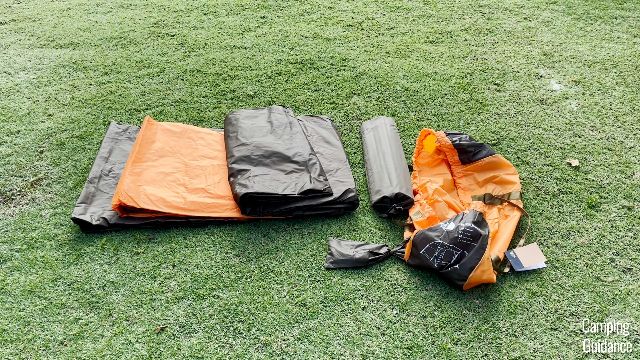
I also took out all the poles, stakes and guylines, and I got these 4 poles, these 14 stakes, plus these 2 orange guylines, all pictured below:

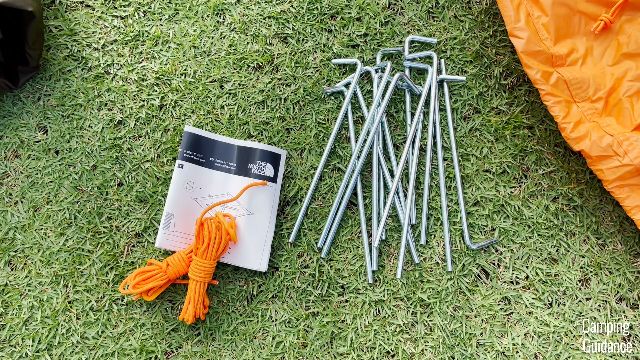
Specifications
Here’s all the data that you might need on The North Face Wawona 6:
Inner Tent Dimensions
- Peak height: 77 inches
- Length: 9 feet 8 inches
- Width: 7 feet 10 inches
- Base area: 75.7 square feet
Vestibule Dimensions
- Length (vestibule): 8 feet 3 inches (*longest length)
- Width (vestibule): 7 feet (*longest width)
- Vestibule area: 51.0 square feet
- Peak height: 74 inches
- Lowest height: 65 inches
Materials
- Floor material: 150D polyester (1,200 millimeters HH rating)
- Bathtub flooring: No
- Tent body material: 75D polyester (1,200 millimeters HH rating)
- Rainfly material: 75D polyester (1,200 millimeters HH rating)
- Pole material: DAC MX
- Number of poles: 4
- Mesh: Micro-mesh (Unsure if it’s no-see-um, not specified)
- Zippers: SBS
Features
- Number of guylines provided: 8 (6 pre-attached, 2 un-attached)
- Number of guy-out points: 11
- Number of stakes: 14
- Number of tent doors: 2
- Number of vestibule doors: 2
- Number of windows: 3 (2 side windows, 1 back window)
- Number of vents: 4 (2 window vents, 2 smaller vents)
- Number of pockets: 9
- Number of lantern loops: 8
- Number of gear lofts: 0
- Room divider: No
- Power port: No
- Black out: No
Portability
- Packed size: 26 x 16 x 10 inches
- Weight: 19.4lbs.
Usage
I also did some testing on my own, and came up with this data:
- Set up timing (1 person): 20 minutes
- Take down timing (1 person): 14 minutes
- Number of single sleeping pads: 6
- Number of queen-sized mattresses: <2
- Number of camping tables & chairs (vestibule): 2 chairs & 1-2 tables
Note: All of this data are my personal measurements, not The North Face’s. My measurements may differ slightly from The North Face’s marketed specs.
Check out the Wawona 6:
Testing and Performance
I put my Wawona 6 through these 28 different tests:
- Set up
- Pack away
- Base area
- Single pad sizing
- Queen bed sizing
- Peak height
- Tent shape
- Vertical wall
- Vestibule area
- Vestibule sizing
- Vestibule height
- Side windows
- Back window
- Tent doors (front)
- Tent doors (back)
- Vestibule doors
- Pockets
- Loops
- Wind protection
- Light rain test
- Light rain ventilation
- Heavy rain test
- Heavy rain ventilation
- 3-day heavy rain test
- Hot day ventilation
- Materials used
- Seam quality
- Portability
1. Set Up
Pros of the Set Up
First, I’ll go through a few things that I liked. For one, I liked that I could set up the entire Wawona 6 on my own, and I’m not even very tall, I’m only about 5’3” (160 centimeters) tall.
And I really loved all the color-coding around the tent. Each pole is fully color-coded, and all the pole sleeves are color-coded, like so:
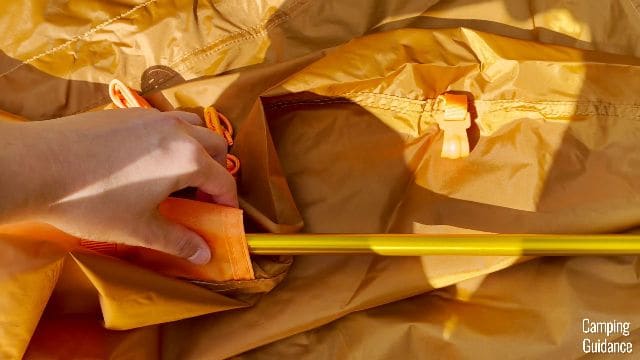
On top of that, all the pole clips, webbings, and rainfly grommets were fully color-coded as well.
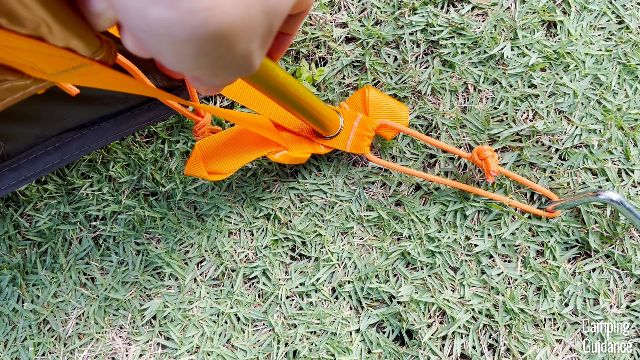
Set Up Timing
It didn’t take me very long too; this entire set-up, including staking and guying out the entire Wawona 6, took me about 20 minutes.
If you need more info on this set up, I put together this step-by-step YouTube guide, which also includes loads of tips on how to set it up by yourself:
Cons of the Set Up
But for now, let’s go through the cons of this set up.
First, for cons, during the set up, I found the orange pole sleeves a little bit long, and each of them snagged between 1 to 3 times.
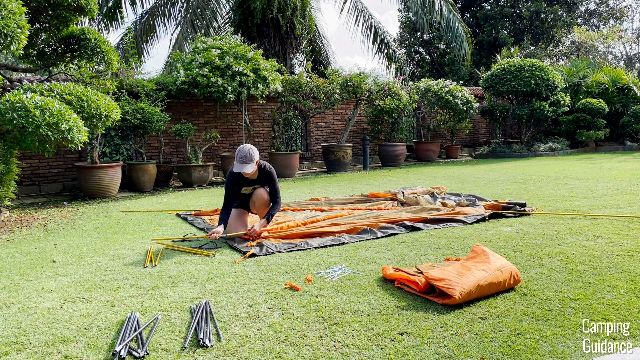
Second, and I think the biggest set up con of all, is that when I was trying to set up the orange poles, the last corner, and only this last corner, was ridiculously difficult for me to set up.

It was extremely tight; I had to not only un-stake that corner, plus the 2 corners next to it, and I also had to use all my strength just to get the pole into the grommet. Altogether, it took me 30 minutes of struggling just to get it in the first time around.
Third, the rainfly of this Wawona 6 has a lot of fabric and pole clips, which always catch either on the tent fabric or the poles. So, setting up the rainfly on my own takes me 2 attempts, sometimes even 3 attempts at getting it up, which really slows down the set up process quite a bit.

Bear in mind that you also can’t set up the tent without the vestibule.
And the last con is that The North Face didn’t give me enough stakes and guylines.
For guylines, on top of the 2 un-attached guylines that I showed you in the Unboxing segment above, I also got 6 of these pre-attached guylines:
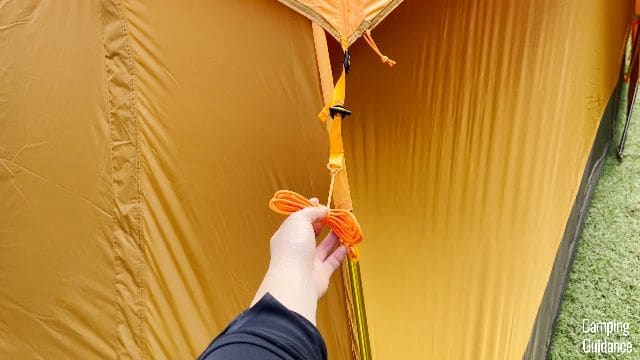
However, even with these, I’m still short about 3 guylines (1 for one of the windows, and 2 more for the 2 vents).
And if I wanted to fully stake down and guy out the entire tent, I’m short about 9 stakes.
- Stakes provided: 14
- Tent base stakes needed: 8
- Vestibule stakes needed: 4
- Guyline stakes needed: 11
- Missing: 9 stakes
2. Pack Away
Pack Away Timing
As for the ease of take down and pack away, unlike the set-up process, I never had any issues with my Wawona 6, and the entire process takes just 14 minutes.
Carry Bag
It’s so user-friendly because the carry bag is really nice, it’s top-loading and the opening of the bag is super big, so you can easily get everything in.
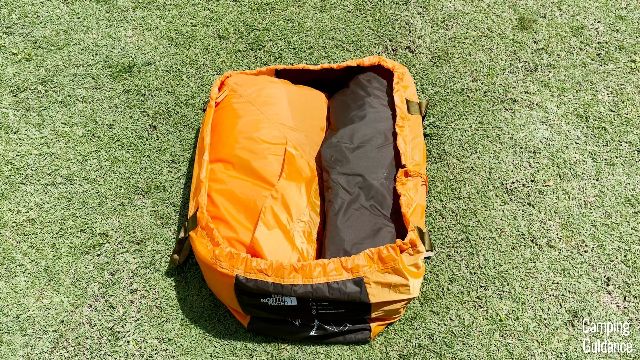
3. Base Area
For the base area, I measured the length of this Wawona 6 to be about 116 inches, and I measured the width to be about 94 inches. This gave me a total base area of 75.7 square feet.
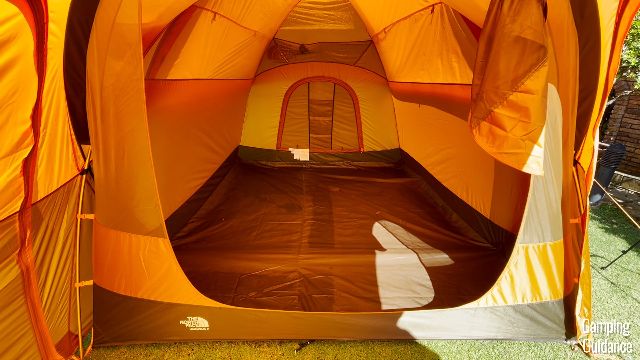
Sadly though, my Wawona 6 was quite a few inches smaller than the marketed dimensions of 120 by 96 inches (see below). So, mine was about 5% smaller than it should be.
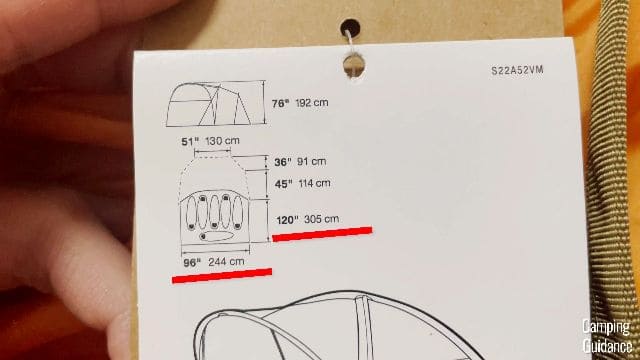
4. Single Pad Sizing
But despite the smaller than marketed base area, I could still fit 6 regular pads in my Wawona 6, and here’s what having 6 pads looks like.
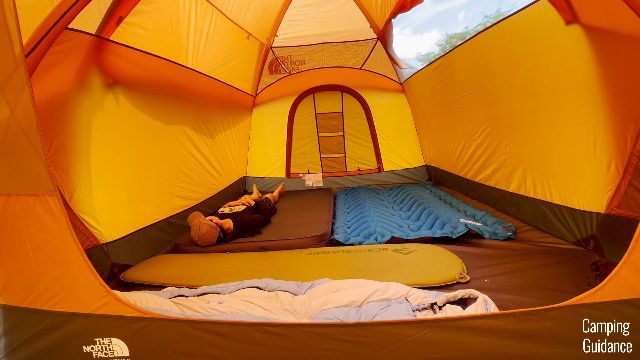
Of course, with 6 pads, you would have to sleep shoulder to shoulder, and as you can see from the picture above, all my pads are basically side by side with each other, so it’s a very tight fit. Here are the pad dimensions if you’re interested:
- Exped MegaMat Duo 10 (green): 74 x 43 inches
- Klymit Double V Uninsulated (blue): 74 x 46 inches
- Sea to Summit Camp Mat (yellow): 72 x 20 inches
There is this small space here, near the front of the tent, but that’s not gonna be enough to fit much of anything.
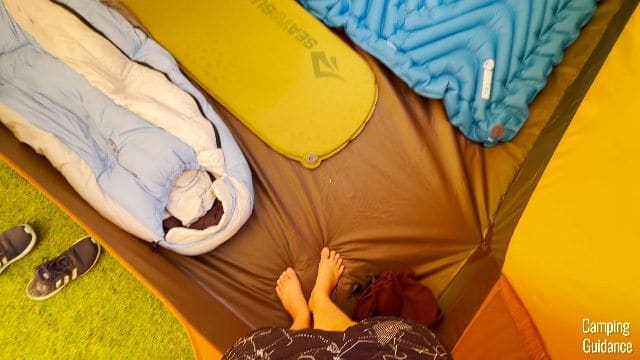
Pro Tip: I definitely do not recommend fitting 6 people in here, because it’s just so tight, especially if you have to sleep at the sides of the tent.
I never like sleeping at the sides of any tent, and in this Wawona 6, my hand would touch the wall of the tent when I raise my arm up:

On top of that, my head definitely grazes the wall when I sit up. Look at how close my head is from the side of the tent!
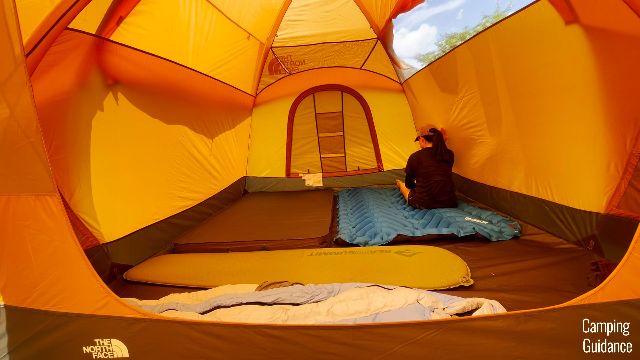
So, to me, it feels a little claustrophobic.
5. Queen Bed Sizing
Instead of 6 pads, I was actually able to fit 2 almost queen-sized beds inside this tent, and here’s what they look like:
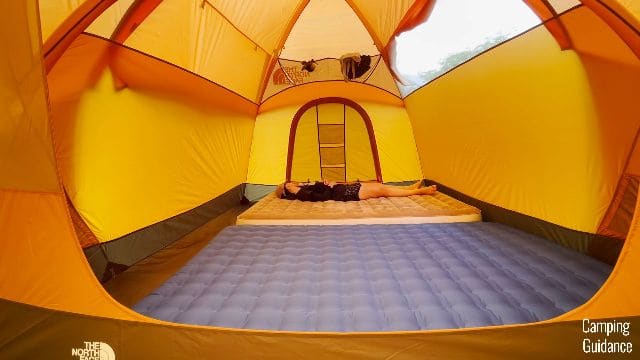
Honestly, even with just 2 queen beds, it somehow still felt pretty tight at the sides. I think that’s because of the slope of the walls, which you can see in this picture below:

Here’s a couple more things to take note of.
First, both my mattresses aren’t exactly a true Queen size of 80 by 60 inches. They’re actually a little smaller, and here are the dimensions:
- Alps Mountaineering Vertex Airbed (blue): 80 x 56 inches
- Etekcity Upgraded Camping Mattress (brown): 80 x 59 inches
And even though they’re both slightly smaller than a Queen, the fit inside this Wawona 6 is already very snug. Both beds touch the sides of the tent, and there’s only a couple inches of leftover space between them. So, there’s no way to fit 2 actual Queen beds in here.
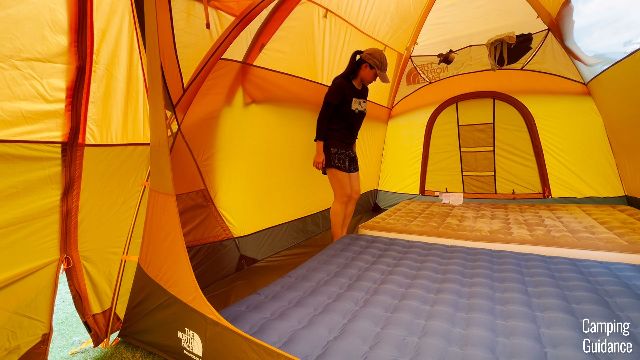
On top of that, with just these 2 almost-queen beds in the tent, there’s barely enough space leftover for me to even walk around in the tent (see above).
Pro Tip: So, my recommendation is to fit at most 1 queen bed in this tent, and here’s what it looks like.

You can also fit a twin bed beside this queen bed, if you want to.
6. Peak Height
The peak height inside this Wawona 6 is about 77 inches, and of course, I’m not very tall (I’m 5’3”/160cm), so I can stand completely upright under the peak height, no problem at all.
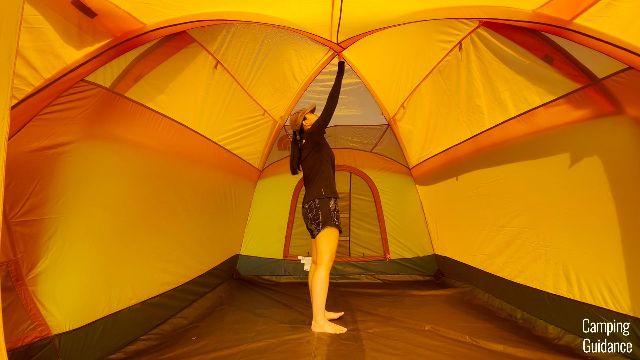
It’s also not the tallest peak height, so I can easily reach the top of the tent by just raising my arm up.
7. Tent Shape
Also, the tent shape of this Wawona 6 is a dome-shaped tent, so just take note that the peak height is only at the center.
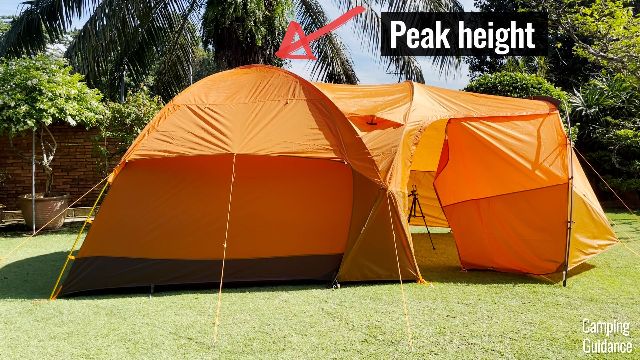
In fact, when I take just 2 small steps away from the peak height, my head would touch the side of the tent right here.
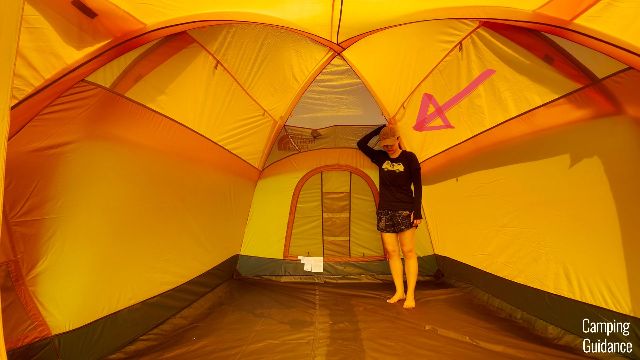
Unlike a cabin tent with vertical side walls, the walls of this dome-shaped Wawona 6 slant inwards a little bit. So, when I stretch my arms out, it touches the sides of the tent very easily (see the red arrows below).
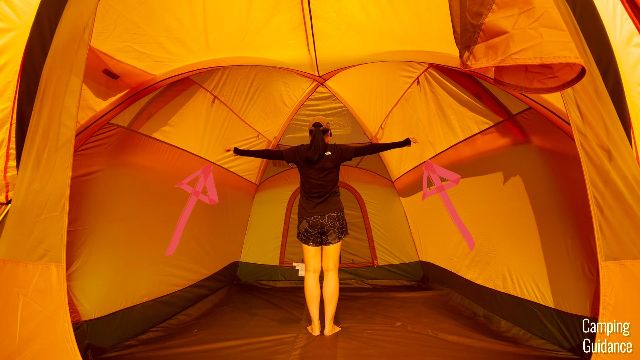
8. Vertical Front Wall
There’s one really cool wall in this Wawona 6, which is the front wall.
It’s actually completely vertical, because of the extra pole that extends the tent fabric outwards, giving me much more livable space nearer the front of the tent.
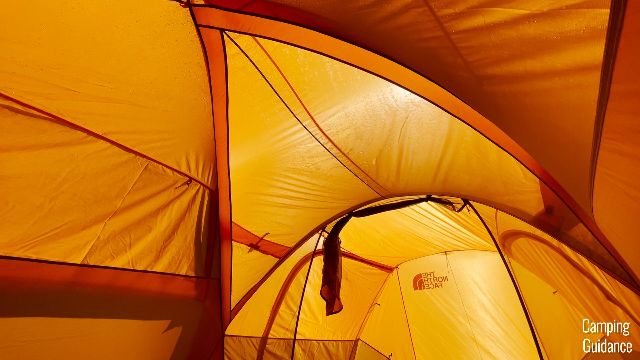
I think you can see it better without the rainfly. Okay, so this is me standing in front of the wall, and notice how I’m able to stand completely upright against the wall?
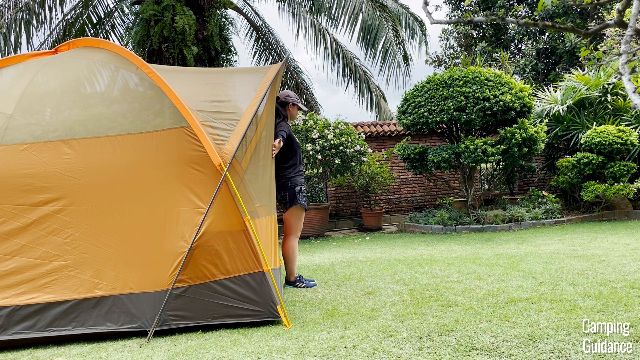
That’s how vertical it is.
And this is the part of the wall that gives you a little more livable space than any other regular dome tent:
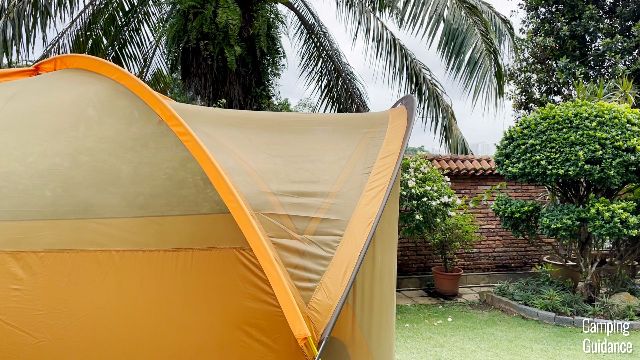
9. Vestibule Area
As for the vestibule area, to summarize, the longest length of the vestibule comes in at about 99 inches, and the longest width comes in at about 84 inches.
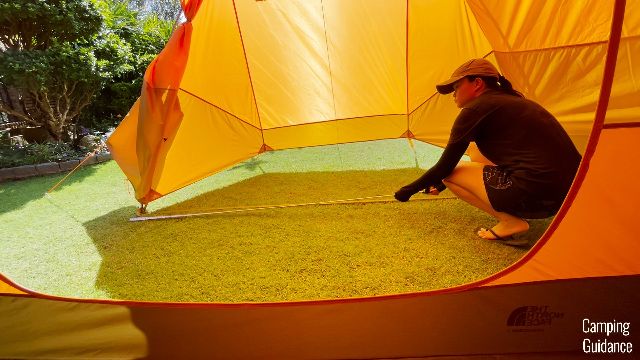
I was pleasantly surprised to find that the total base area of this Wawona’s vestibule is a whole 14% bigger than marketed, coming in at a whopping 51.0 square feet.

10. Vestibule Sizing
Now, for the vestibule sizing, I used a couple of my REI chairs (the REI Camp X Chair and Camp Xtra Chair), and set them up in the Wawona’s vestibule.
I found that both these chairs fit perfectly into the vestibule with a ton of leftover space for even a camping table.

When I re-arranged both these chairs, they really fit perfectly as well, so you get tons of flexibility on how you wanna store your stuff in the vestibule.

11. Vestibule Height
The height inside the vestibule is pretty consistent throughout the entire vestibule, but it does taper down a little bit towards the end.
The side of the vestibule nearest the inner tent has a peak height of about 74 inches, and it slowly tapers down all the way to the other side, which has a height of about 65 inches.
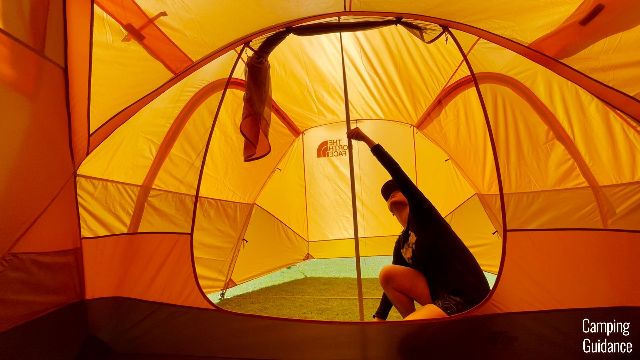

So, overall, for the vestibule, there was a ton of livable space, and I was very impressed by it.
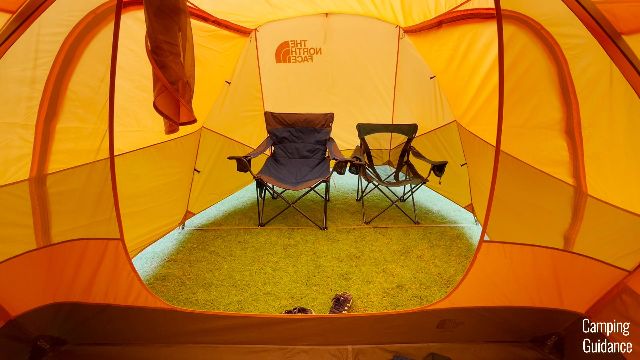
12. Side Windows
Number of Windows
Moving back to the inner tent, this Wawona 6 has 3 windows in the tent, let’s talk about the 2 side windows first, and here are some pros and cons.
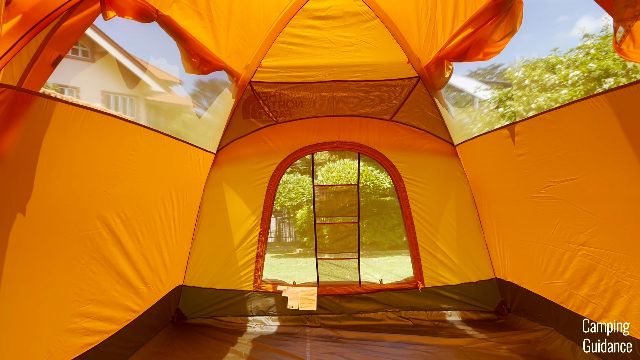
Side Window Usage
I checked each of the side windows, found only mesh, and there was no way that I could open them from the inside of the tent.
So, whenever I wanted to open these side windows, I had to go out of the tent, and open them from the outside. Why? I’m not sure either.
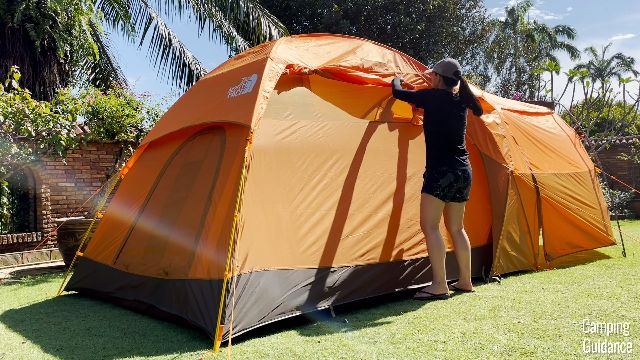
Side Window Features
But anyway, to open these windows, there’s 1 zip and 1 Velcro strip on each side of each window:

And to keep these windows open, you’ll get 2 of these toggles at the top to tie the window fabric up.
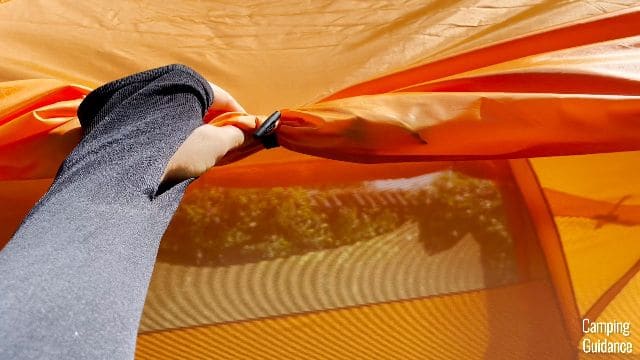
There’s no zipper or Velcro at the bottom of each window though, but there is a guy-out loop at the bottom, so you can guy this window out for some ventilation.
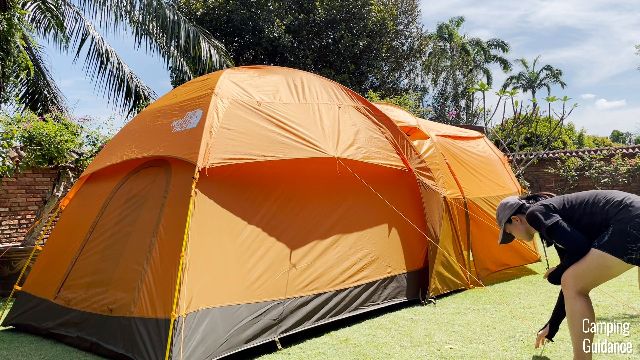
Side Window Dimensions
When opened, each window measures about 69 inches in length and 16 inches in width, so not the biggest.
Side Window Zippers
And also, the zippers on the windows are SBS, and I found them to be completely snag-free and good quality.
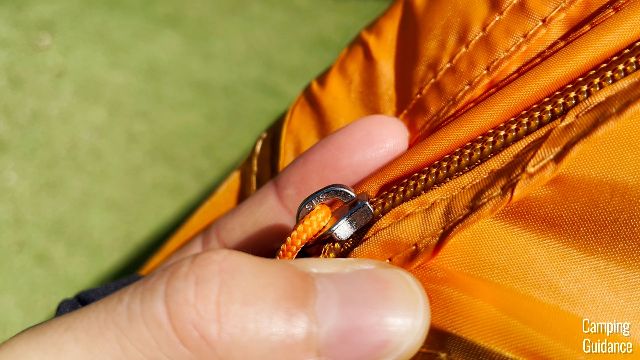
13. Back Window
Back Window Usage & Features
The last window is actually at the back of the Wawona 6, and while I liked that I could open and shut this window from the inside of the tent, the process was a little bit annoying.
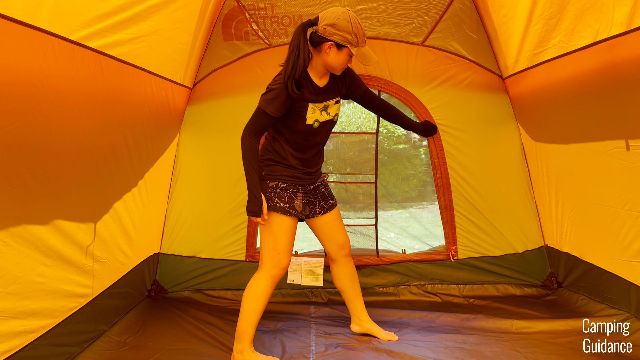
I first had to unzip the inner window fabric, then unzip the outer door fabric, then tie that door fabric up using these 2 toggles at the bottom of the window, and then, finally, I get to zip up the window. So, it takes some time just to get the window open.
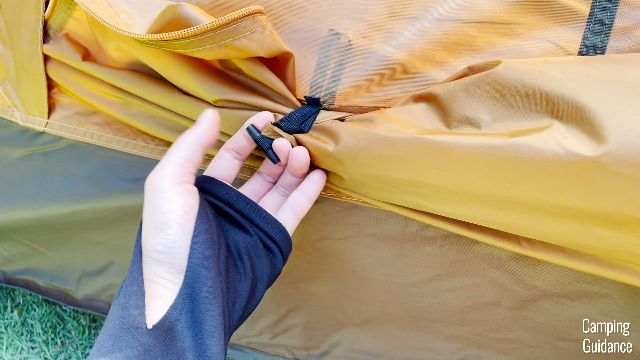
Back Window Dimensions
When open, this last window measures about 42 inches in length by 37 inches in width, so not super big as well, and also, the storage pockets block your view a little bit.
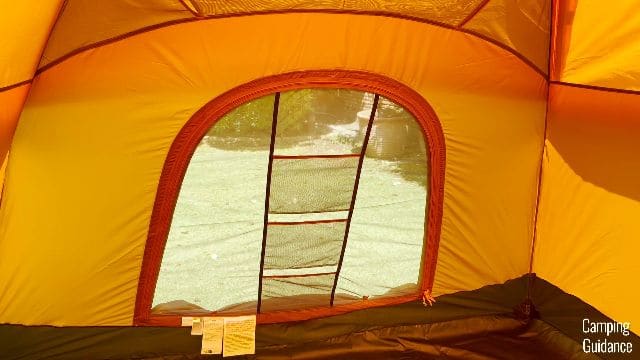
Back Window Zippers
But I did like the SBS zippers though, they’re completely snag-free as well.
14. Tent Doors (Front)
Number of Doors
Moving onto the tent doors, this Wawona 6 has 2 doors, and again, I’ll give you all the pros and cons that I could think of as well.
Front Door Usage
This is the front door of the Wawona 6, and I found it to be completely snag-free. I needed to use only 1 hand to unzip the entire door, and unzipping it fully takes just 3 seconds.

Front Door Features
After that, to keep the front door open, I had to roll the fabric up neatly, and tie it to the top with these 2 toggles. This takes another 15 seconds or so to do.
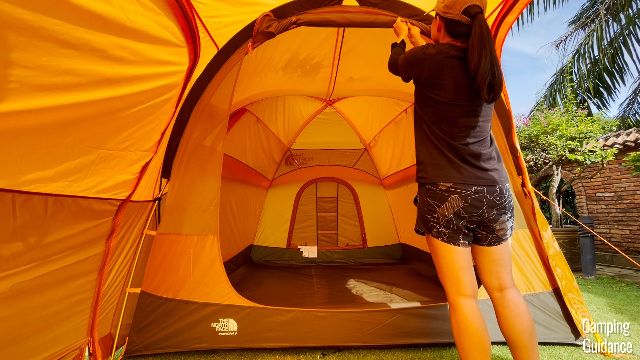

Front Door Dimensions
When open, this front door has a longest length of 60 inches, and a longest width of 58 inches, so basically it’s pretty big, and it’s about 3 times my size.

This front door also measures 70 inches from the ground to the top of the door, which is also much taller than my height.

So, when walking in and out of the Wawona 6 through this front door, I never had to duck at all, which is super nice.
Front Door Zippers
I also love how zipping this door up takes only 3 seconds as well, it’s completely catch-free, and the zippers are made of SBS. I do wish it could have been YKK, but SBS isn’t too bad.

Front Door Mesh
On top of that, I love how a good three-quarters of this front door is made of mesh for tons of ventilation.
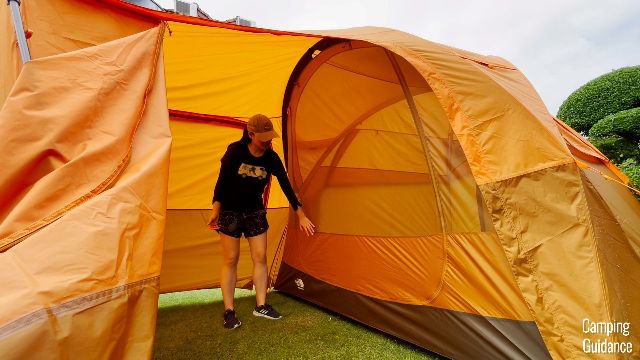
The mesh looks fine and high quality, and I think it could be no-see-um mesh (although this wasn’t specified by The North Face). Let’s just stick to calling it ‘micro mesh’.
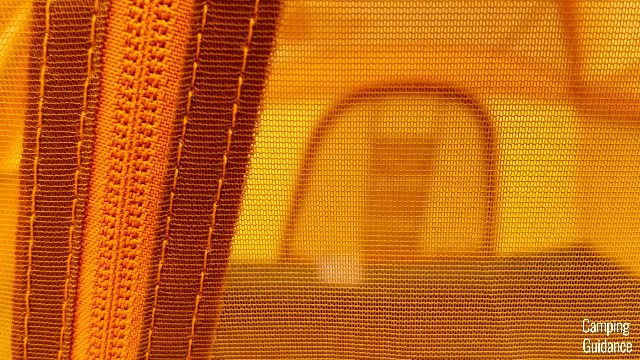
As for cons, well, I don’t think this front door has any of them. I loved it, and it’s really great.
15. Tent Doors (Back)
Back Door Zippers
Now, this is the back door of the Wawona 6, I like that it’s completely snag-free, takes about 3 seconds to zip and unzip as well, and the zippers are the same as the front door, they’re SBS zippers as well.

And that’s it for the pros. Now, here are some cons.
Back Door Usage & Features
First, and I found this to be the most annoying, to keep this door open, I had to unzip not just the outer door fabric, I had to unzip the inner window fabric as well, then I had to tie up the inner window fabric first, before I could tie up the door fabric.
Notice me holding the 2 different fabric layers in the picture below:

And that’s because there’s only the same 2 toggles for tying both the window and door fabric up together.
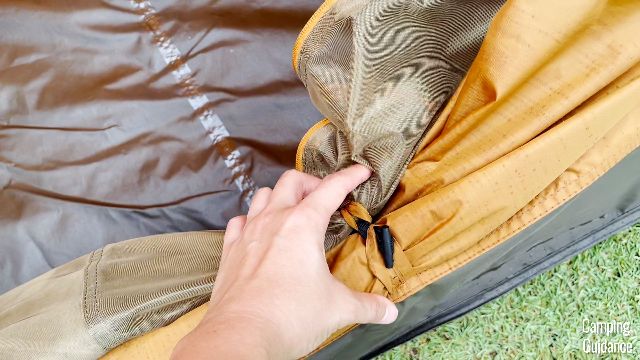
And also, I wish that The North Face would have color-coded the door and window zippers, right now they’re all just orange in color, and I kept pulling on the wrong zipper.
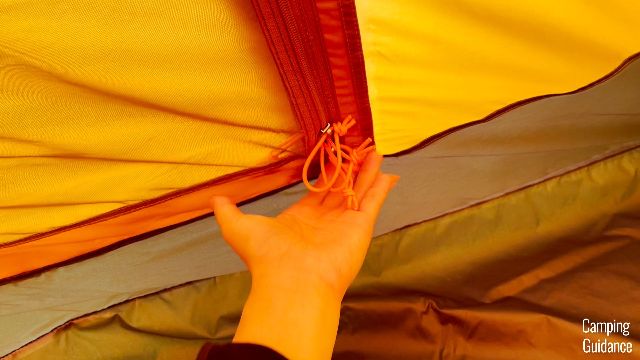
Back Door Dimensions
When opened, this back door is actually really quite small, it measures just 42 by 37 inches, and 48 inches from the ground to the top of the door.
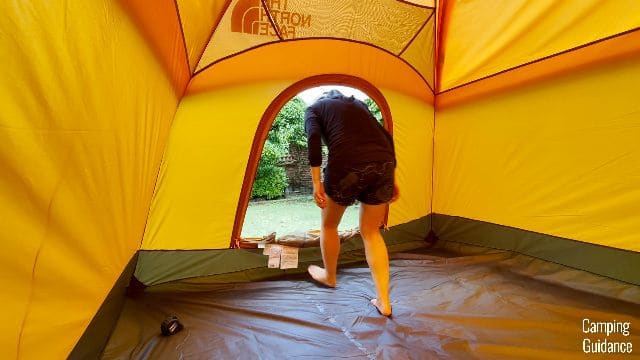
So, even if you’re not tall like me, you still would have to duck down quite a bit to get through the door.
16. Vestibule Doors
Number of Vestibule Doors
This Wawona 6 has 2 vestibule doors, one on the right, one on the left, and both are exactly the same.
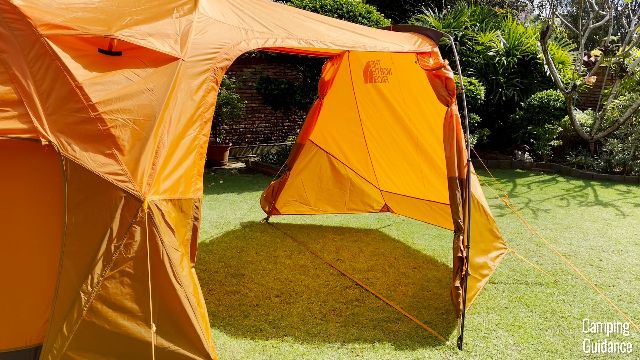
Vestibule Doors Zippers
The zippers are SBS as well, so decent quality, and each vestibule door has 2 of them.
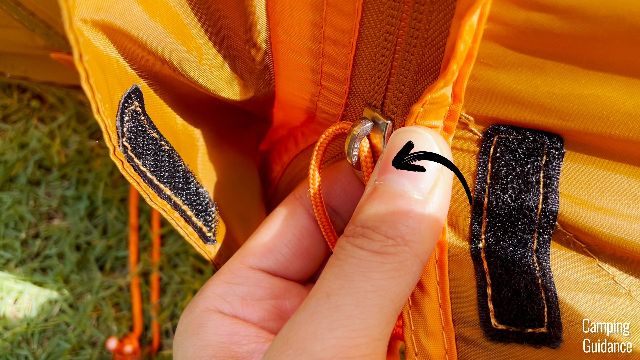
When I was unzipping each of the vestibule doors, they were completely snag-free, one-handed, and took 3 seconds.
However, when I was zipping up the vestibule doors, I found that the rain flap or storm flap from the outside tends to get in the way of the zipper track. Not always, but only sometimes.


Vestibule Doors Features
To keep these doors open, each vestibule door comes with 2 toggles by the side to tie the door fabric up.
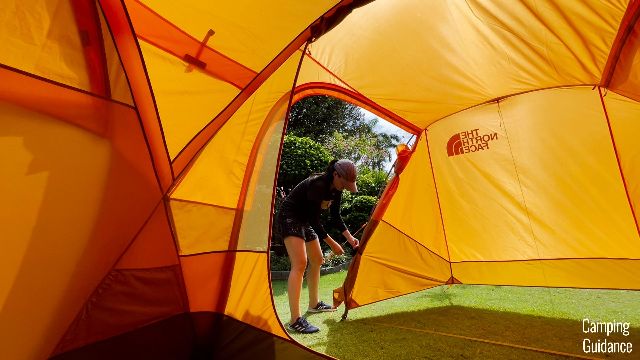
Vestibule Doors Dimensions
Each of these doors measured about 53 inches in width, they were about 3 times my size, and each door also measured about 58.5 inches from the ground to the top of the door.

Not exactly super tall, but it was okay. I still had to duck a little to get in and out of the vestibule.
17. Pockets
Number of Pockets
For pockets, this Wawona 6 has 9 of them in total.
There are 4 pockets over the small back door, 3 pockets on the window fabric of the back door (first picture below), plus 2 more pockets at the sides nearer the front of the tent, 1 at each side (second picture below).

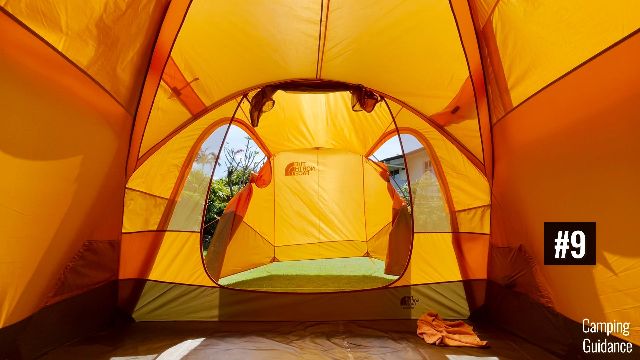
Pocket Positioning
Unlike some of the more budget-friendly tents, I love that all these pockets in the Wawona are protected by either the back door fabric, or the rainfly fabric, so that there won’t be any leaking into the tent through the pocket seams.
You can see the outline of the rainfly in the 2 pictures below, which shows that the pocket seams are well protected from the rain:
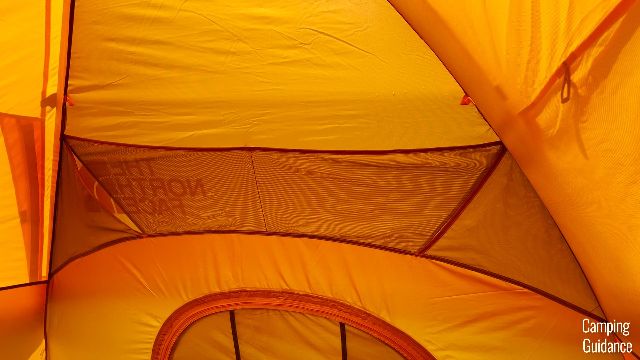

The positioning of the pockets is pretty smart.
On top of that, I really liked that I had some pockets that I could access when sitting down, like the back door pockets and side pockets, and also more pockets up top that I could access when standing up.

18. Loops
For loops, this Wawona 6 also has quite a few of them. In total, there are 8 loops.
There’s 1 loop right at the very top of the tent, at the center, plus 4 more loops around it.
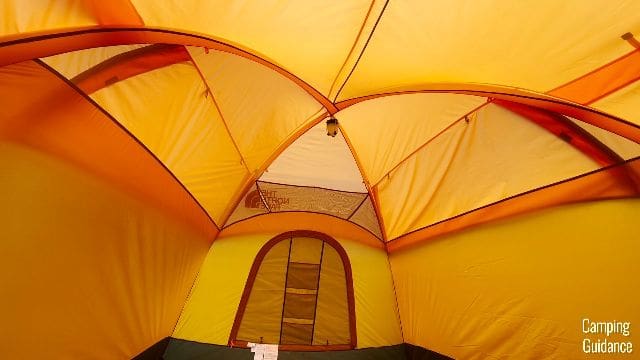
Also, there’s another 3 more loops in the vestibule, so you can hang tons of stuff from all these loops or some lanterns for lighting at night.

19. Wind Protection
Wind Test
For wind protection, I was able to test this Wawona 6 out in light to slightly more moderate winds of about 10 to 15 miles per hour, and it held up like a champ.
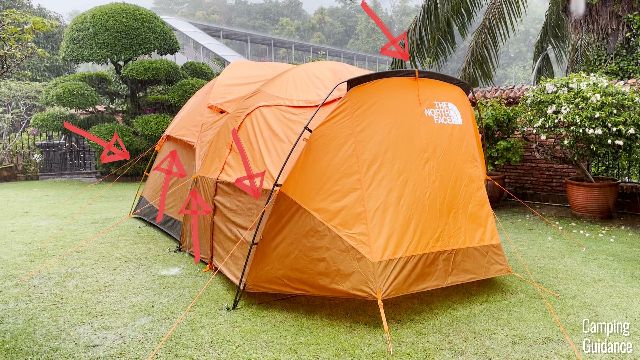
I had almost the entire tent guyed out, so that really helped.
Number of Guylines
I love that each length of this Wawona 6 can be held down by 5 guylines, plus 1 more guyline at the vestibule, so a whopping 11 guylines in total.

Also, this Wawona is mostly dome-shaped, which sheds wind pretty well.
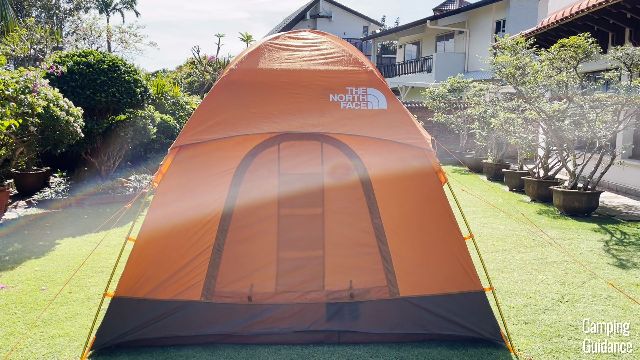
I have a friend who gave me his old Wawona 6, after using it through crazy winds of like 50 miles per hour.

Yes, the poles ended up bending a bit, but they never broke, and I was even able to set up and continue using the old Wawona. So, very sturdy in the wind.

20. Light Rain Test
I put my Wawona 6 through about one hour of fairly light rain. After the hour was up, and the rain stopped, I didn’t find a single leak inside this Wawona 6 at all, and it held up super well.
21. Light Rain Ventilation
Also, for light rain ventilation, I found that I could leave all the vents open, and no water got into the tent through the vents.
22. Heavy Rain Test
And because the light rain test just wasn’t heavy enough, here’s my heavy rain test.
How I Rain Tested my Wawona 6
It rained super heavily for about 3 hours, and I put every single part of this Wawona 6 through an insane amount of heavy rain.
This picture was not edited in any way; that’s how heavy the rain was:
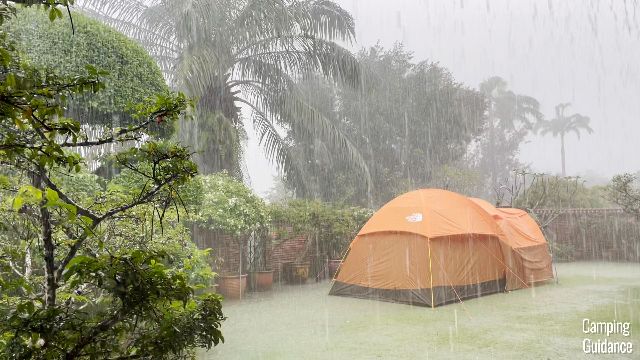
In fact, it rained so heavily that after a few hours, my entire yard was flooded (so flooded that the water was up to my ankles).

And when I checked my Wawona 6, I found that the entire bottom of the tent was completely submerged in the water.
One of the corners of my tent was even sitting in like 2 inches of water, like so.
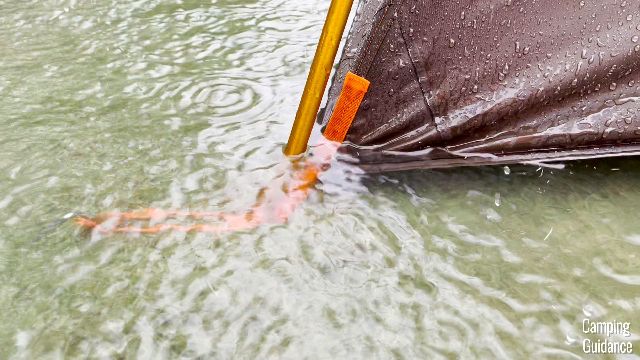
Rain Test Results
After the rain stopped, I checked in on the tent, and found that there was not a single drop of water inside.
I also checked the seams at the corners, this was the corner that was submerged in 2 inches of water, and I found absolutely no leakage at all.
Even when I pressed down on the corner seam gently, there was no dampness at all. (My hand was completely dry!)
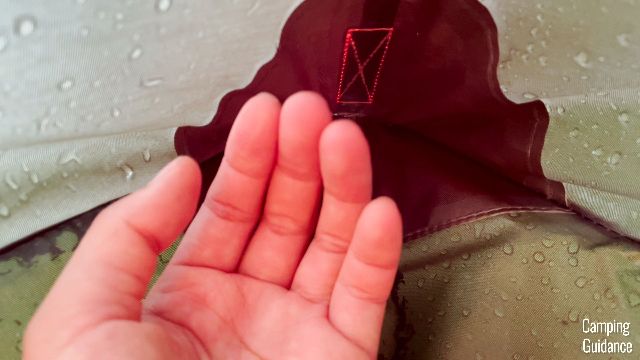
I also checked the rest of the seams, the flooring, and all the fabric around the tent, and none of them leaked, despite being exposed to so much rainfall.
23. Heavy Rain Ventilation
Window Vents
For ventilation, I found that these 2 window vents didn’t leak at all, despite the heavy rain plus relatively moderate winds.
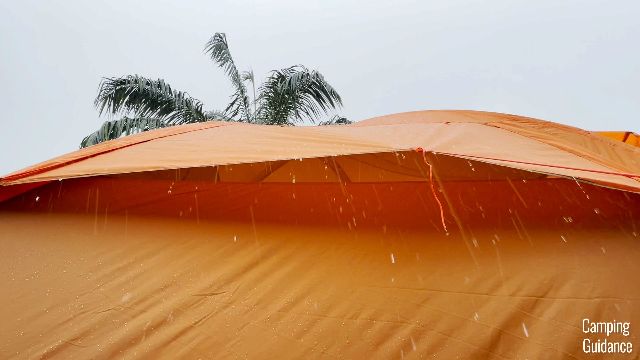
But just bear in mind that the rainfly doesn’t overlap the window mesh very much, probably only 4 to 5 inches or so, like this, so this might be an issue in horizontal rain (which I didn’t experience).
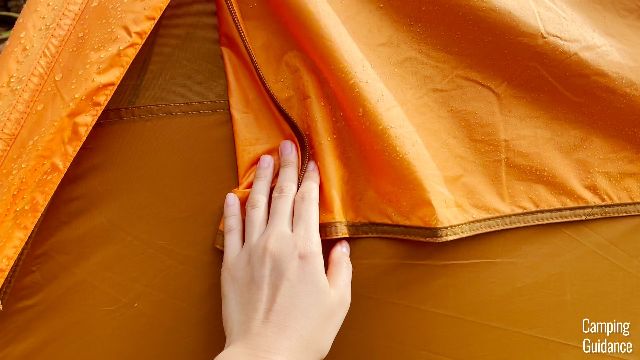
Regular Vents
On top of that, this Wawona also has 2 of these smaller vents.
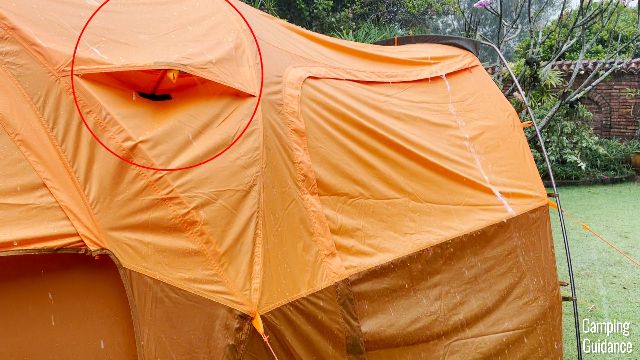
I noticed that they’re almost facing downwards, and it’s the perfect angle that water doesn’t go into the tent at all.
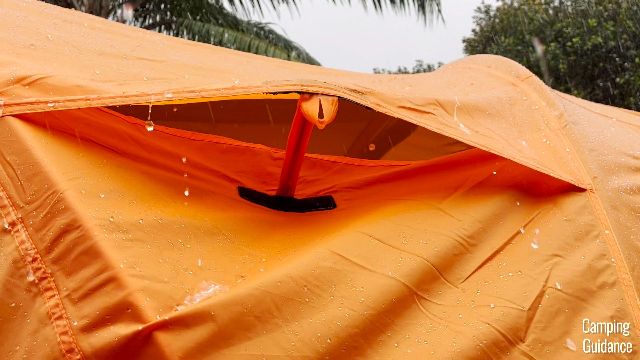
After the heavy rain stopped, I checked the vent from the inside of the tent, and the mesh was completely dry.

Rainfly Ventilation
And apart from these 4 vents in the tent, there’s also a small gap between the rainfly and the ground at the vestibule. The ground is a little bit flooded, but you still get ventilation.

24. 3-Day Heavy Rain Test
And if you want to know the breaking point of this Wawona 6, well, I found it after putting it through a whopping 3 afternoons of really heavy rains.
After the third day of heavy rain, I noticed that this wall with the back door was slightly damp from the inside.
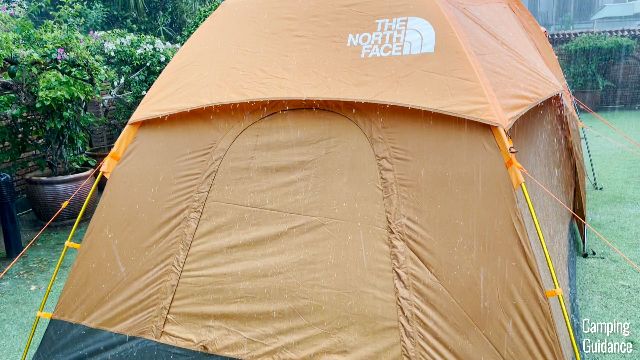
It didn’t drip into the tent or anything, but my hand was slightly damp from touching the wall.
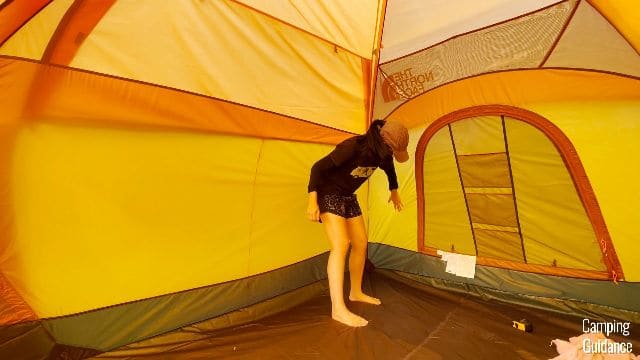
And it was only this wall that was slightly damp after the 3 day heavy rain test, while the rest of the walls were still completely dry from the inside.
My theory? I could be wrong about this, but I think it’s because this back wall was exposed to the most rain.
For the sides of the tent, there’s this guy-out point on each side that allowed me to guy out this window vent, which I think gave the Wawona a little more rain coverage.

On the other hand, the back wall doesn’t have a guy-out point, the rainfly is much closer to the tent body, so less rain coverage, and more water over the tent. Hence, the slight dampness.
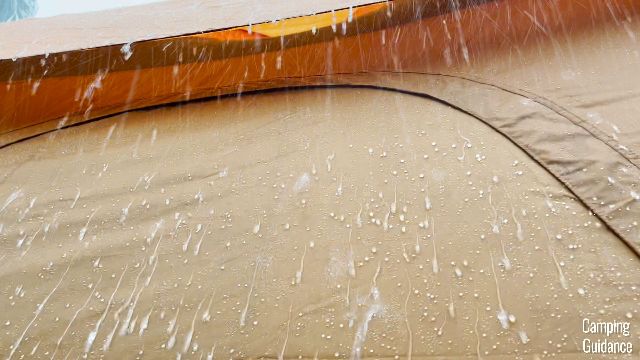
If you prefer to watch the rain test instead (there are way more details and rain test clips in it), I’ve embedded my YouTube video right here:
25. Hot Day Ventilation
Moving onto hot day ventilation, I like to take the rainfly off on sunny days, and if you do so, you’ll get a nice mesh roof for stargazing.
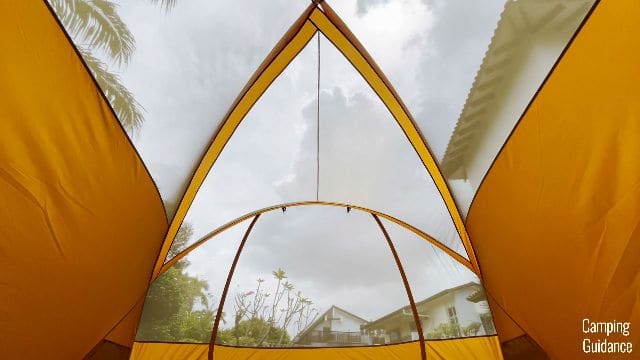
And I really love the mesh of the front door, there’s so much of it for lots of ventilation. The rest of the walls have a little less mesh though, and here’s what they look like.

26. Materials Used
Flooring
For the materials used to create this Wawona 6, well, the flooring is made of 150-denier polyester with a hydrostatic head rating of 1,200 millimeters.
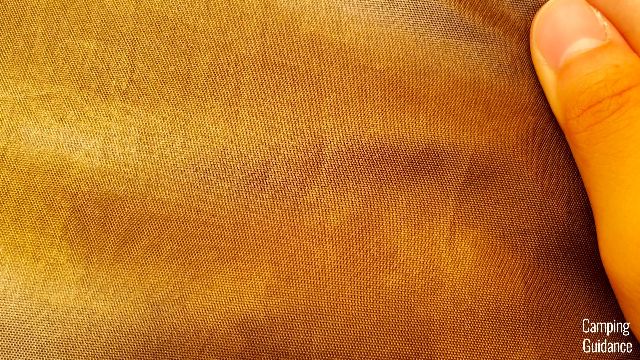
Tent Body & Rainfly
The rest of the tent body and the rainfly is made of 75-denier polyester, so half as thick as the flooring, but they also have the same waterproof rating of 1,200 millimeters.
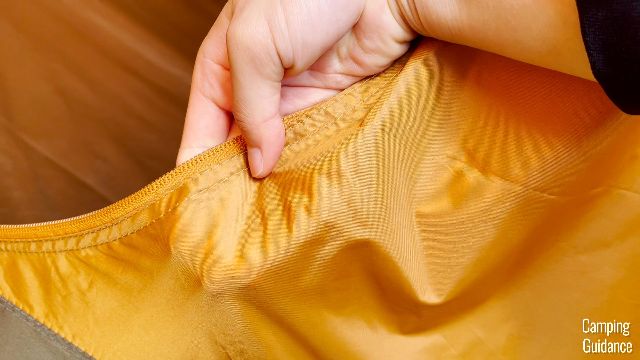
Poles
All 5 poles of the Wawona 6 are made of high-quality DAC aluminum.
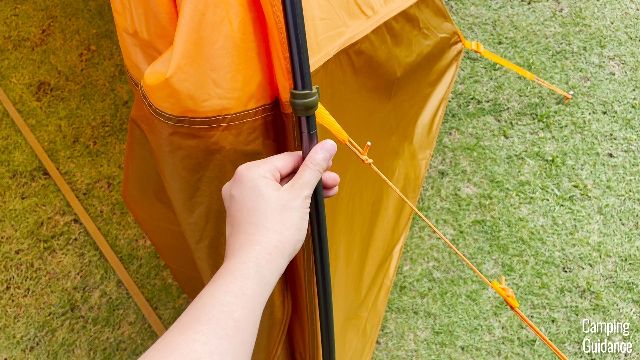
Zippers & Mesh
The zippers are SBS, and the holes of the mesh are very fine.

27. Seam Quality
I also looked at the quality of the seams, and I found them to be nicely double-stitched, and consistent all around the tent.
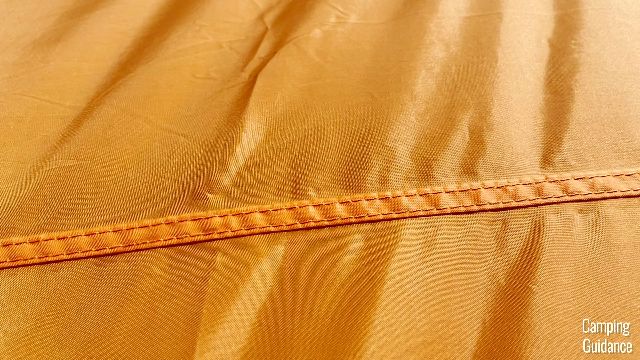
I didn’t find a single loose thread at all, all the seams were properly reinforced when they needed to be, especially at the corners, which is attached to the stake loops and pole grommets.
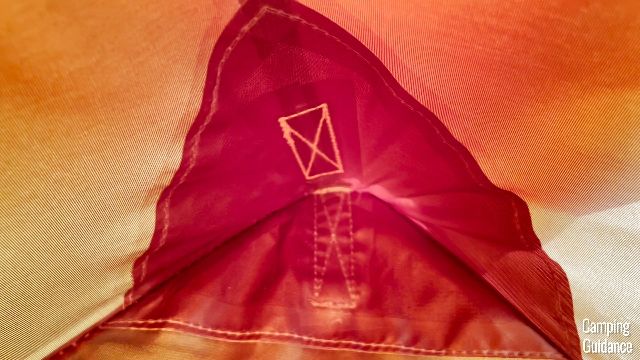
28. Portability
Packed Size
For portability, I measured the packed size of my Wawona 6 to be about 26 by 16 by 10 inches.
Here’s what it looks like beside my Coleman 2-Person Sundome Tent, and also one of my 32-ounce Nalgene bottles.
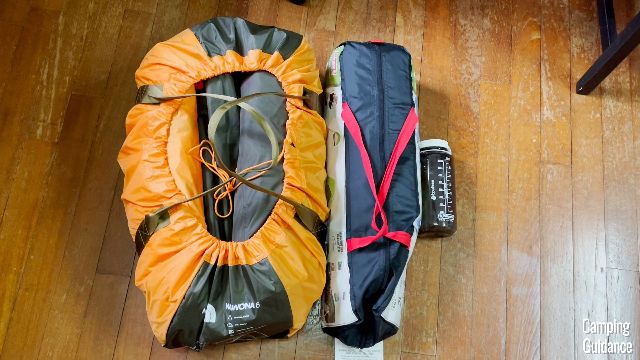
Ease of Carry
The carry bag comes with a hand strap at the top, plus another smaller strap by the side, and a fabric covering/flap that covers the contents of the bag.
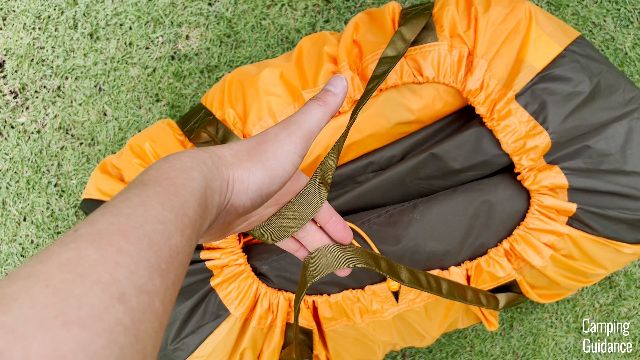
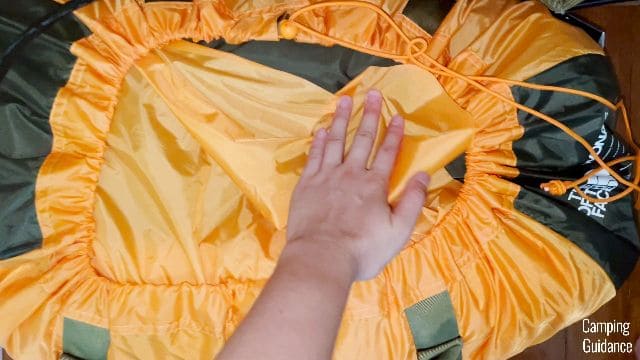
I wish they made the strap at the top a little bigger though so I can more easily sling it over my shoulder, right now I find it way too short.
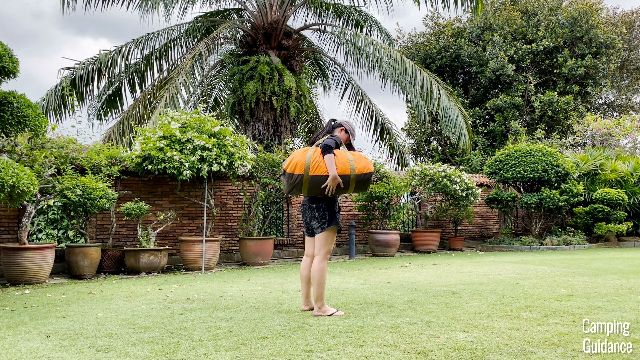
Weight
This Wawona 6 weighs about 19.4 lbs. for everything, including all the provided stakes and guylines.
Pros and Cons
Pros
1. Phenomenal rain protection
For pros, I think the best thing about The North Face Wawona 6 is easily the phenomenal rain protection.
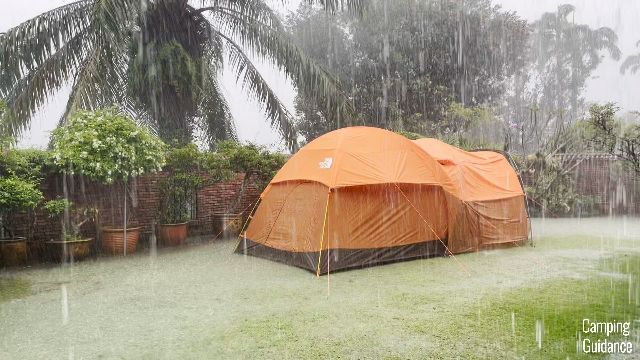
I was really lucky to have been able to put this tent through the worst rain I’ve seen all year, 3 afternoons of non-stop, heavy, pouring, flooding rain, and this Wawona survived much better than any other family camping tent I’ve seen so far.

2. No seam sealing required
On top of that, there’s no seam sealing required for this tent. I checked the entire Wawona 6, and it was perfect, really.
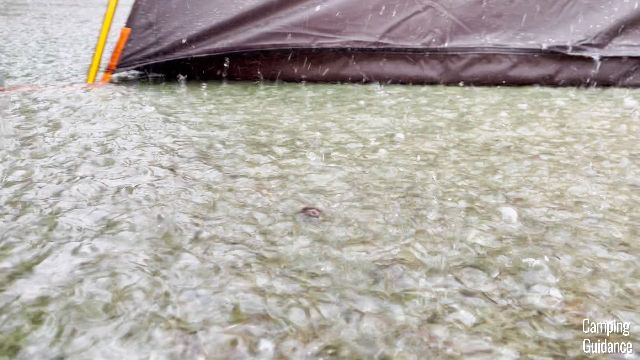
So basically, all the rainfly seams were taped (I checked it from the vestibule), and on the inside of the tent, you can make out the rainfly from the inside, and all the seams not covered by the rainfly have been seam taped.
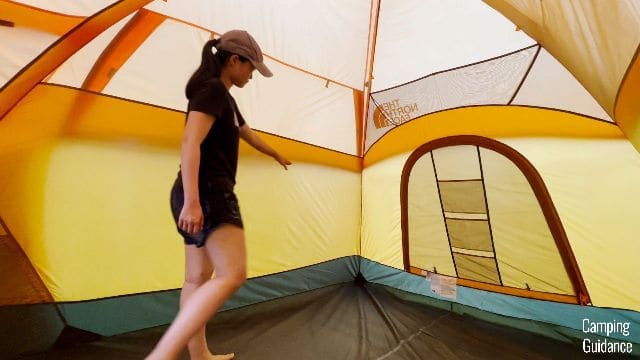
Yes, every single one. It’s awesome, it’s so rare to find a tent with all the proper seam taping.
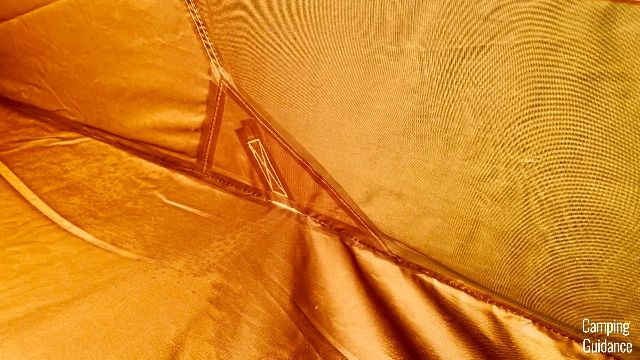
3. Great wind protection
Wind protection, in addition to rain protection, is great as well.
4. High quality materials
On top of that, I found this Wawona 6 to be made of very high quality materials.
In addition to all the materials I mentioned in Test 26 of this post, I want to expand a little bit more on the quality of the poles, because that was really impressive.
5. DAC MX poles
All the poles of this Wawona 6 are made of aluminum, not just regular aluminum, but top-of-the-line DAC MX, which is stronger and sturdier.
In the 3 weeks that I spent testing my Wawona 6, through crazy rains and some winds, none of my poles even bent at all, even in the slightest.
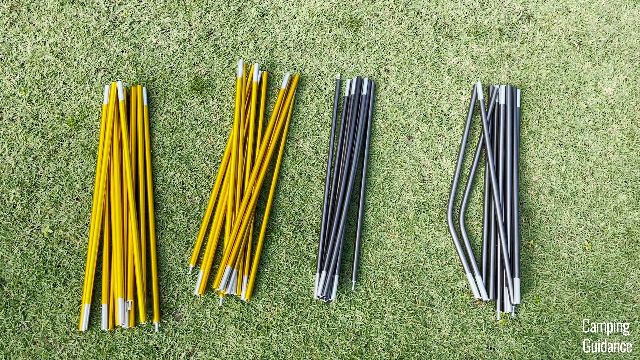
I also really loved how easily they snapped together, and stayed together, which makes this tent all the more user-friendly.
6. Huge vestibule
The vestibule of this Wawona 6 is also incredible, one of the biggest I’ve ever seen in a family camping tent.
The 2 black poles of the Wawona 6 create this awesome vestibule with fairly consistent height throughout, and the entire vestibule, even the shortest height all the way at the end (65 inches) is actually still slightly taller than my height.

So, I found that I could stand upright throughout the entire vestibule.
7. Lots of ventilation
I love that the vestibule also comes with 2 doors for lots of cross-ventilation. That, plus the 2 inner tent doors, when you open all 4 of these doors, you kind of get a huge wind tunnel for lots of ventilation. And this is with the rainfly still on the tent!

If you take the rainfly off, you get even more ventilation.
8. Amazing front door and front wall
And the front door is huge, I love that I could take even entire double pads in and out of the tent.
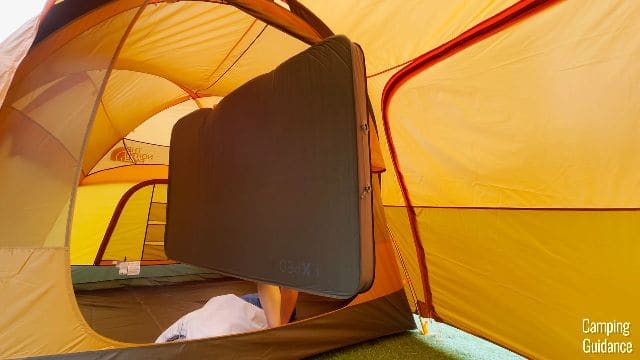
Plus, the wall that the front door is on is also amazing, and I’ve gone through all of the incredible pros under these sections:
- Section 8: Vertical Wall
- Section 14: Front Tent Door
9. Lots of storage
There’s also a decent amount of storage options, with 9 pockets and 8 loops, although there aren’t any other features like gear lofts, room dividers, and e-ports.
Check out the Wawona 6:
Cons
As for cons, I think there are 2 bigger ones, and 1 smaller fixable con.
1. Smaller than average base area
First, I think the base area is easily one of the smallest I’ve ever seen in a 6-person tent. You can technically fit 6 people, but I recommend fitting a maximum of only 3, to possibly 4 adults.
2. Windows accessible only from outside
Also, I found it a tad annoying that the 2 side windows are accessible only from the outside of the tent.

So, if you have the windows open, and then it starts raining, you’ve got to run out of the tent and zip the windows shut from the outside, before coming back into the tent.
3. Needs breaking in
I also found the set-up of this Wawona 6 to be very tight the first time around, and I talked about this in ‘Test 1: Set Up’.
To fix this, I recommend breaking in this tent in your yard or your house before going camping.
Recommendation
Now that we’re done with the pros and cons, here is my recommendation to you.
I think The North Face Wawona 6 is one of the best family camping tents in the summer. There’s a ton of ventilation, although this also means that there’s too much mesh for you to use it in much colder weather. But for summer, it’s absolutely perfect.
And if you’re expecting tons of rain and wind, don’t worry, because this Wawona 6 has got you covered in the worst of rainstorms.
Check out the Wawona 6:
Bonus: Must Read!
But wait, I say it’s one of, but is it the best tent for you?
If you wanna see how this North Face Wawona compares to other similar camping tents on the market, I highly recommend that you check out this post where I spent over $2,000 buying and 6 months testing the best 6-person tents on the market.

I also featured the Wawona 6 in these comparisons:
- The Best Waterproof Family Tents (This features 3 family tents and 2 smaller tents.)
- The Best Family Camping Tents
- Wawona V.S. Base Camp
- Wawona V.S. Wonderland
- Budget V.S. Expensive Tents (Sundome V.S. Wawona)
Or, check out the Wawona 6, if you’ve already made up your mind:







